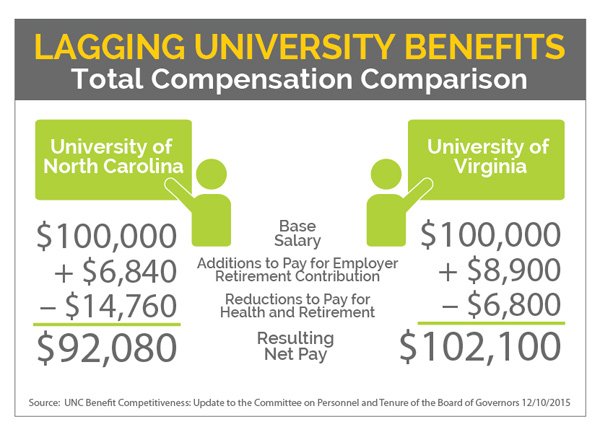CHAPEL HILL – Stagnant pay for University faculty and staff remains a major problem in North Carolina, hampering the state’s ability to hire and keep top-tier teachers and researchers.
State lawmakers have offered a single 1.2% raise in the past seven years, even as other states have recruited aggressively to poach talent.
But it’s more than salaries.
Lackluster benefits — especially in retirement and health care — deepen the challenge. University employees face higher premiums, less generous coverage and smaller retirement contributions than their peers at other public universities, according to an analysis presented last week to the UNC Board of Governors.1
That causes real harm to the University’s talent pool, said Matt Brody, the University system’s vice president for human resources.
“When I’m interviewing folks, where they’re really focused is what kind of retirement program do we have and what’s the employer contribution? What am I going to pay out of pocket for healthcare, and what are the premiums?” Brody said. “That’s where the rubber really hits the road.”
It’s a persistent weakness. Especially for those trying to support a family, North Carolina’s health coverage lags far behind the University of Virginia, the University of California and other competitors. Family coverage for a North Carolina instructor costs more than three times similar coverage at Virginia Tech, for instance.2 Premiums, benefits and deductibles for the State Health Plan are set by the Plan’s board, with oversight from the General Assembly.
When total compensation is compared, a professor making a nominal salary of $100,000 at the University of Virginia comes out $10,000 ahead of one making the same salary at UNC-Chapel Hill. The UVA instructor has total compensation of $102,100, while the UNC instructor’s is $92,080.3
“As you can see, that’s real money if you’re someone who’s weighing a potential offer,” Brody said. “This is not nickels and dimes; this could make a real difference.”
While the state’s pension plan stacks up well against other public universities, the defined-contribution retirement plan — a more flexible and popular option for many faculty and staff — is in the bottom third among peer institutions. UNC’s employer contribution has not increased in more than 18 years, which has allowed competitors to outpace the University’s plan.4
Together, the expensive health coverage and meager retirement contributions make UNC job offers less competitive in the national market.
“These are the most critical for us in recruitment and retention, and this is where we’re struggling,” Brody told board members.
A long-awaited study of faculty pay is expected at the Board’s January meeting.
1 “UNC Benefit Competitiveness,” http://www.northcarolina.edu/apps/bog/index.php?mode=browse_premeeting&mid=5628&code=bog.
2 Ibid, Slide 9.
3 Ibid, Slide 19.
4 Ibid, Slides 11-17.


A. Kahn says
That example of disparity between UVA and UNC would be far better represented if it showed what the average UNC -system junior faculty ACTUALLY makes. The net of $92k a year is at least 2.5 times more than MANY of us take home annually ($40,000 or less!). We have PhDs, we have been teaching, researching, and mentoring for several years; serving hundreds of students each every semester, which equates to $$$$ in tuition dollars. THIS average faculty salary is what I believe highlights the true issue with recruitment and retention; not to mention demonstrates our “value” to the state.
Andy R. says
I completely agree. The graphic stopped me in my tracks from sharing this story with other friends outside of academe. The round 100K number makes for a nice base of comparison, but it’s so far out of the realm of me and my other Assistant Professor colleagues earn at our regional university I’d be afraid folks might get the wrong message.
M. Smith says
I agree with A. Kahn’s comments above. This is a real problem. However, until I read this article, I was under the assumption that nothing was being done about the benefit problem in the UNC system. I am encouraged to see that Matt Brody is at least speaking out about it and hopefully attempting to make real change. The current problem with the structure is that benefit premiums for an average income family cost so much there is no money left over in the monthly income to USE the benefit. My $650+ payment toward premiums each month (the lowest option for my family of 3) leaves nothing left for me to afford a visit to the doctor, let alone x-rays, physical therapy, or anything preventative. My $650+ is being wasted because I can’t afford to use it. Something has to be done about this!
Mary Ann Frese Witt says
When I was first hired as an assistant professor at NCSU, I was offered a salary much lower than my previous salary because, the department head said, “You have a husband to support you.” As I rose to the rank of full professor, the percentage of my raises was good, but with such a low base, the raises never amounted to much. Now I am retired, my husband is no longer around to support me, and my retirement and medical benefits are not great. Luckily I earned a decent income from royalties . I am sure that women faculty members are treated more equitably now. If not, they must speak up!